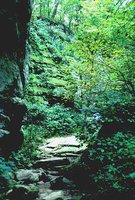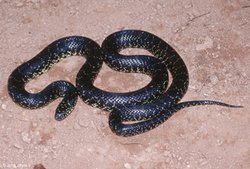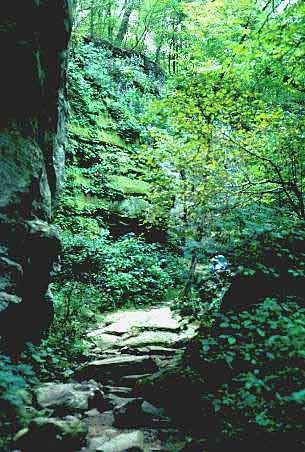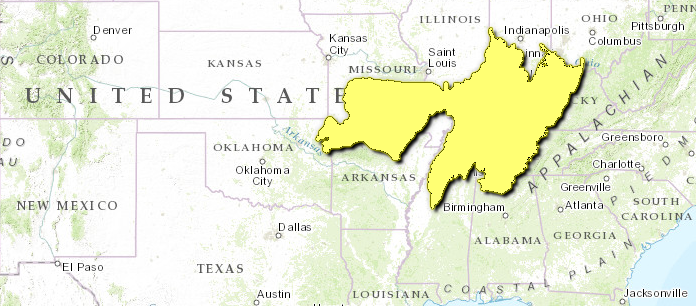Central U.S. hardwood forests
Introduction Like the ecoregions (Central U.S. hardwood forests) to the east, broadleaf deciduous trees dominate the Central U.S. hardwood forests. This region receives less precipitation than the more coastal areas, however, so drought-resistant oak-hickory forests predominate here. While other forests in the United States and Canada have both oak and hickory, this region was once the only one where both species occurred in abundance over a large area. Much of the natural habitat in this ecoregion has now been destroyed by development and agriculture. Most of the areas covered by the Central U.S. hardwood forests is rolling, but some parts are nearly flat and the Ozark highlands reach approximately 1,000 meters (m). Parts of Kentucky and Tennessee are marked by dissected plateaus and basins.
Biological Distinctiveness
 Giant State Park, Illinois, United States. (Photograph by U.S. National Park Service)
Giant State Park, Illinois, United States. (Photograph by U.S. National Park Service) The Central U.S. hardwood forests ecoregion is among the richest in North America for herbaceous plants and shrubs, with 2,527 species. The tree flora is less diverse, dominated by only a few species. The oak-hickory forest becomes more savanna-like in its northern reaches. In southern Illinois and Indiana, the forest forms a mosaic with prairie. Widepsread dominants are white oak (Quercus alba), red oak (Q. rubra), black oak (Q. velutina), bitternut hickory (Carya cordiformis), and shagbark hickory (C. ovata). Flowering dogwood (Cornus florida) often occurs in the understory, along with sassafras (Sassafras spp.) and hop hornbeam (Carpinus spp.). The shrub layer is distinct, often with evergreens, and wildflowers are common. Intact wetter sites feature American elm (Ulmus americana), tuliptree (Liriodendron tulipifera), and sweetgum (Liquidambar styraciflua).
Conservation Status
Habitat Loss
Only about one percent of the Central U.S. hardwood forests remains as intact habitat. The majority of the ecoregion has been heavily altered by human activity, particularly conversion to agriculture, short rotation silviculture, and pasture in some areas (e.g., bluegrass).
Remaining Blocks of Habitat
All the remaining blocks of habitat in this ecoregion are smaller than 1,000 square kilometers (km2). The most important are:
- Mammoth Cave - south-central Kentucky
- Land between the Lakes - southeastern Kentucky, northeastern Tennessee
- Hoosier National Forest, Yellowwood Nathional Forest - southern Indiana
- Edge of Appalachia - central Tennessee
- Western Highland Rim - eastern Tennessee
- Lower Missouri Ozarksm - southern Missouri
- Tennessee Cedar Glades - central Tennessee
- Missouri Ozarks/southern Mark Twain National Forest - southern Missouri, northern Arkansas
- Shawanee Hills - southern Illinois
- Big River Junction - eastern Illinois
- Wolf River - southeastern Tennessee
- Fort Campbell - northern Tennessee, southern Kentucky
Degree of Fragmentation
 Black Kingsnake (Lampropeltis getula nigra), Kentucky, United States. (Photograph by John White & CalPhotos)
Black Kingsnake (Lampropeltis getula nigra), Kentucky, United States. (Photograph by John White & CalPhotos) Most of this ecoregion has been highly fragmented, so large predators have disappeared. The remaining habitat blocks have some degree of connectivity, but few corridors exist between blocks. Degraded corridors within the blocks may be restorable, though the focus should be on improving the integrity of large blocks.
Degree of Protection
Mammoth Cave, Edge of Appalachia, and parts of the Missouri Ozarks and the Tennessee Cedar Glades are the only blocks of habitat in the ecoregion to enjoy substantial protection. These areas do not adequately protect the habitats of the central U.S. hardwoods.
Types and Severity of Threats
Urban sprawl and agricultural conversion are the greatest conversion threats to the region. Invasion of exotic grasses, cave vandalism, and overuse for recreation, fire suppression in fire-maintained systems, and loss of large ungulates (bison) are degrading the remaining natural [[habitat]s]. Deer poaching continues to be a problem in Kentucky and Tennessee, and collection of wild herbs is ongoing across the region.
Suite of Priority Activities to Enhance Biodiversity Conservation
- Improve integrity of existing natural [[habitat]s]
- Continue to identify existing biodiversity hot spots and protect them. These are important places that conserve the full range of communities and species within the ecoregion, some of which will be small, some large, some connectible, and some not.
Conservation Partners
- Alabama Natural Heritage Program
- Arkansas Natural Heritage Commission
- Illinois Natural Heritage Division
- Indiana Natural Heritage Data Center
- Kentucky Heartwood
- Kentucky Natural Heritage Program
- Mississippi Natural Heritage Program
- Missouri Natural Heritage Database
- The Nature Conservancy
- The Nature Conservancy - Midwest Reg. Office
- The Nature Conservancy - Southeast Regional Office
- Ohio Natural Heritage Data Base
- Oklahoma Natural Heritage Inventory
- Tennessee Division of Natural Heritage
Relationship to Other Classification Schemes
This ecoregion corresponds roughly to the southern half of Bailey’s Eastern Broadleaf Forest (Continental) Province. The northern portion of Bailey’s Province should be distinguished on the basis of climate, vegetation types, and ecosystem dynamics. Omernik classifies the Ozark Highlands as a separate ecoregion, while we believe these rightly belong with the central U.S. hardwoods.
Additional Information on this Ecoregion
- For a shorter summary of this entry, see the WWF WildWorld profile of this ecoregion.
- To see the species that live in this ecoregion, including images and threat levels, see the WWF Wildfinder description of this ecoregion.
- World Wildlife Fund Homepage
| Disclaimer: This article is taken wholly from, or contains information that was originally published by, the World Wildlife Fund. Topic editors and authors for the Encyclopedia of Earth may have edited its content or added new information. The use of information from the World Wildlife Fund should not be construed as support for or endorsement by that organization for any new information added by EoE personnel, or for any editing of the original content. |

